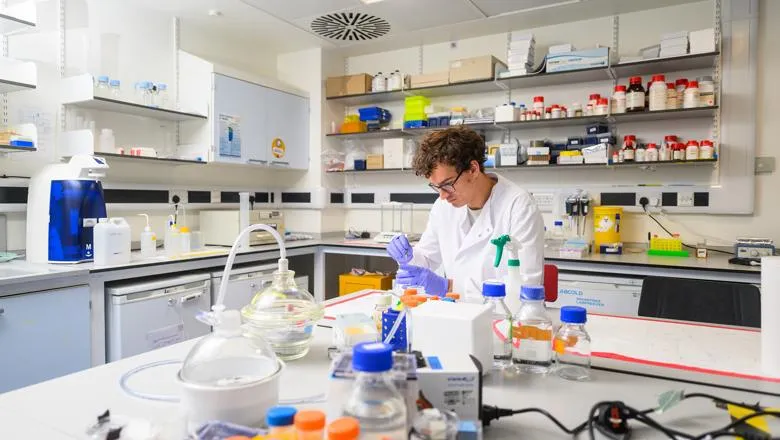NAMs and AI-enabled predictive models are rapidly enhancing our ability to understand and predict the effects of chemicals on humans and wildlife. These new approaches are increasingly contributing to safety decision-making across different sectors while reducing the need for animal testing where alternative methods are viable.
Dr. Luigi Margiotta-Casaluci, Senior Lecturer in Mechanistic and Integrative Toxicology at King's and a HSAC member
11 November 2024
New recommendations published on how to improve and accelerate testing of chemicals
New recommendations from DEFRA’s Hazardous Substances Advisory Committee (HSAC) have set out steps that could make the UK a world leader in more ethical, safer, and cost-effective chemical testing, through early adoption of a risk-based approach to regulation (also called next generation risk assessment).

Recommendations for the adoption of New Approach Methodologies (NAMs) in UK chemical regulation has been published by the Department for Environment, Food & Rural Affairs (DEFRA). The report includes contributions from experts at the University of Birmingham, King’s College London and the HSAC members.
NAMs are modern methods of chemical testing that utilise advanced technologies to enhance the assessment and regulation of hazardous chemicals by improving the relevance, performance, speed and reliability of toxicological testing, and to support a transition away from animal testing.
The report finds that the UK’s technological and scientific capabilities in public health and safety are substantially advanced enough to make the country a global leader in using NAMs for chemical safety assessments.
Iseult Lynch, Professor of Environmental Nanosciences at the University of Birmingham (UoB) and Chair of the HSAC said: “The current approach to chemicals regulation, which relies on animal testing, has failed to keep pace with the number of chemicals on the market, and has not kept pace with the advances in science that are providing new insights into the toxicology of substances and their mixtures for assessing health risks to humans and the environment. The time is right for the UK to begin the transition to NAMs-based regulation.”
He added: "However, achieving large-scale impact will require coordinated strategies for accelerating their adoption in regulatory settings, both in the UK and internationally."
Key Recommendations for UK Chemicals Regulation include:
- Adoption of a technology-agnostic definition of NAMs based on an understanding of chemical modes of action.
- Setting of criteria for NAMs to be considered within a progressive regulatory framework, beginning with criteria for their use in chemical grouping and prioritisation.
- Application of a Progressive Regulatory Framework that utilizes NAMs for a wide range of regulatory applications as the certainty of the findings for hazard assessment increases.
- Establishment of UK centres of excellence and a UK national reference laboratory for the development and validation of NAMs to ensure the uptake of technological improvements within the government and private sectors.
- Incentivisation of chemical registrants under UK REACH* to provide NAMs data indicative of the modes of action of their substances to support the implementation of a “group first” approach to chemical safety assessment.
John Colbourne, Professor of Environmental Genomics at the University of Birmingham and Director of the Centre for Environmental Research and Justice (CERJ) is optimistic that the technological roadblocks towards this transition are finally lifted after more than a decade of substantial public and private scientific investments. “The UK is in a position to harvest from the investments of almost a billion pounds from national and European funded research by revisiting what types of evidence are needed to provide greater protection from toxic chemicals, which can now be part of current legal reforms in the UK, post-Brexit.”
As well as the suggestion that the UK could be a world leader in NAMs if these recommendations are followed, the report also argues that the strategic implementation of NAMs can significantly reduce, refine, and potentially replace the use of mammalian animals for chemical safety testing, while improving hazard assessment robustness and efficiency.
The report concludes that a progressive regulatory framework is the essential first step in moving toward the integration of NAMs, which can reduce testing costs all while improving the safety and sustainability of the chemicals industry.
Dr Margiotta-Casaluci is from The Institute of Pharmaceutical Science (IPS). The Institute collaborates closely with industry partners, clinicians, regulators, and policymakers to translate its world-leading research into real-world impact. Within IPS, the Genetic & Environmental Toxicology Section carries out pioneering research in mechanistic and predictive toxicology, dedicated to understanding the mechanisms and pathways through which chemicals, pharmaceuticals, and environmental contaminants cause adverse health effects in humans, model organisms, and wildlife. The Section’s ultimate goals are to leverage this cutting-edge research to enhance the protection of human and environmental health, and to develop state-of-the art educational programmes that will train the next generations of toxicologists.

